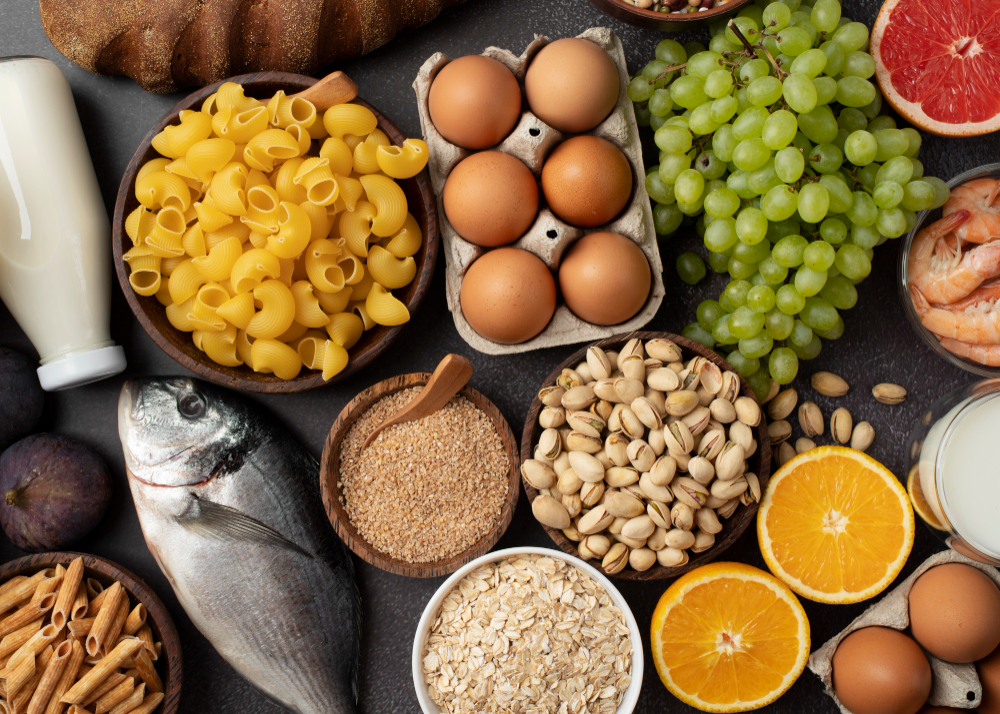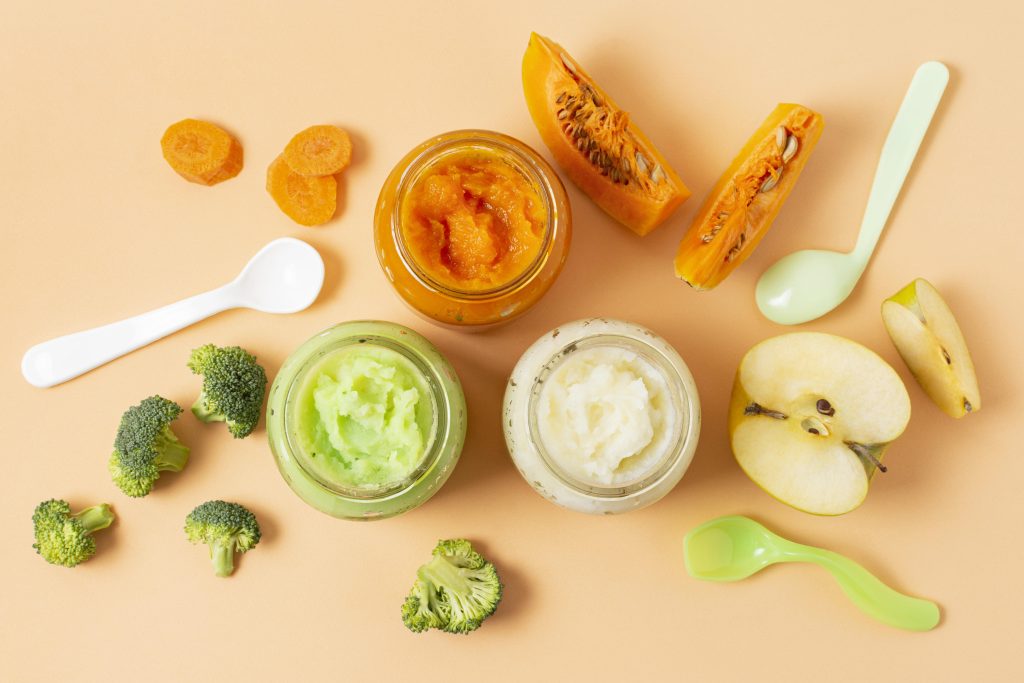When Can Babies Start Eating Baby Food? Introducing Solid
Are you eagerly awaiting the moment when your little one can start exploring the exciting world of solid foods? You may be wondering, “When can babies start eating baby food?” Well, the answer is it depends!
But fret not; we’re here to help you navigate this important milestone with ease. Have you started thinking about what flavors and textures to introduce first? Or perhaps you’re wondering how to tell if your baby is ready for solids.
Join us as we venture on a journey of baby food discovery, covering everything from purees to finger foods. Get ready to witness the joy on your baby’s face as they take their first bite and explore new tastes and textures. So, are you ready to start this exciting journey with us?
Discover when can babies start eating baby foods, learn about important milestones, and get expert guidance on providing a safe and enjoyable eating experience for your little one. Let’s undertake this nourishing journey together.
Introduction to Feeding Solid Foods

Introducing solid foods to babies is an essential milestone in their development. It not only helps them explore new flavors and textures but also provides essential nutrients to support their growth. Understanding when babies can start eating baby food is crucial for their overall health and well-being.
Feeding babies solid foods offers several benefits:
- Firstly, it allows them to receive a wider range of nutrients that cannot be provided by breast milk or formula alone.
- Essential vitamins and minerals found in solid foods contribute to healthy bone development, brain function, and overall growth.
- Moreover, the introduction of solid foods helps develop babies’ oral motor skills and coordination, preparing them for chewing and swallowing more complex textures.
Knowing when babies are ready for solid foods is equally important. According to the American Academy of Pediatrics (AAP), most babies are ready for solid foods around six months of age.
However, it’s essential to consider their individual developmental readiness, which includes the ability to sit up and hold their head steady, as well as showing an interest in food. It is recommended to consult with a healthcare provider before introducing solids to ensure the baby’s readiness.
Introducing solid foods is an exciting and significant step in a baby’s eating journey. In the following sections, we will explore the appropriate age to start baby food, tips and guidelines for introducing solid foods, as well as milestones and safety measures to consider throughout this process. Let’s venture on this delicious and nutritious journey together!
When Can Babies Start Eating Baby Food?

Introducing solid foods to your baby is an exciting milestone, but it’s important to know when they are ready for this new experience.
The American Academy of Pediatrics recommends starting solids around six months of age, as this is when most babies have the developmental readiness to handle solid foods. However, every baby is unique, so it’s crucial to look for signs of readiness before introducing baby food.
The following developmental milestones can indicate that your baby is ready for solid foods:
1. Head control
Your baby should be able to hold their head steady and sit upright with support.
2. Tongue-thrust reflex
The tongue-thrust reflex, where babies push food out of their mouth with their tongue, typically diminishes around six months.
3. Increased curiosity
If your baby shows interest in what you’re eating, reaches for food, or tries to grab your spoon, they may be ready for solids.
4. Loss of the extrusion reflex
The extrusion reflex, where babies automatically push food out of their mouths, usually disappears by around four to six months.
Remember that solid foods should never be introduced before four months of age, as a baby’s digestive system may not be fully developed yet.
It’s also essential to consult with your healthcare provider before starting solids to ensure that your baby is developmentally ready and to discuss any specific considerations based on your baby’s health.
Keep in mind that feeding solids should complement, not replace, breast milk or formula, which should continue to be the primary source of nutrition for your baby. By waiting until your baby is developmentally ready to start eating baby food, you can ensure a smooth transition and support their nutritional needs.
Introducing Baby Food: Tips and Guidelines

When it comes to introducing baby food to your little one, it’s important to follow some tips and guidelines to ensure a smooth transition. Here are some recommendations on how to introduce baby food to babies, including the recommended first foods, portion sizes, and feeding schedules:
Start with Single-Ingredient Baby Foods
- When introducing solids, it’s best to start with single-ingredient baby foods.
- These include pureed fruits and vegetables such as mashed bananas, soft-cooked apples, or pureed carrots.
- Starting with one ingredient at a time helps you identify any potential allergies or intolerances your baby may have.
- It’s recommended to wait a few days before introducing a new food to monitor for any adverse reactions.
Gradually Increase Texture and Variety
- As your baby becomes comfortable with purees, you can gradually increase the texture and variety of foods.
- Introduce slightly thicker purees and mashed foods to help develop chewing and swallowing skills.
- You can also introduce soft finger foods like avocado slices or well-cooked pasta pieces.
- Offering a variety of flavors and textures exposes your baby to different tastes and helps them develop a healthy palate.
Pay Attention to Portion Sizes
- While introducing baby food, it’s essential to pay attention to portion sizes.
- Start with small amounts, around one to two tablespoons, and gradually increase as your baby’s appetite grows.
- It’s normal for babies to initially consume small amounts and gradually increase their intake over time.
- Trust your baby’s hunger and fullness cues and avoid overfeeding.
Follow a Feeding Schedule
- Establishing a feeding schedule can help create a sense of routine and predictability for your baby.
- Aim for three meals a day, with additional breast milk or formula feeds in between.
It’s important to note that breast milk or formula should still be the main source of nutrition for babies under one year old. As your baby gets older, you can gradually increase the number of meals and introduce snacks.
Remember, every baby is different, and it’s essential to follow your baby’s cues and consult with your pediatrician or healthcare provider for personalized guidance. Introducing baby food should be an enjoyable experience for both you and your little one as they explore new tastes and textures.
Milestones in a Baby’s Eating Journey

As babies grow and develop, their eating journey evolves. Understanding the milestones in a baby’s eating journey can help parents navigate the introduction of solid foods with confidence. Here are the key milestones to look out for:
Starting with Purees
- At around 4 to 6 months of age, babies are typically ready to begin their solid food journey.
- Pureed foods like squash, sweet potatoes, or applesauce are great options to start with.
- Begin by offering small spoonfuls of puree once a day, gradually increasing the frequency as your baby shows interest and tolerance.
Progressing to Thicker Purees
- Around 6 to 8 months, babies can handle slightly thicker purees with more texture.
- This allows them to practice chewing and swallowing.
- Offer mashed fruits and vegetables, as well as pureed meats or legumes.
- You can also mix different flavors to introduce variety and expand their palate.
Exploring Finger Foods
- Between 8 and 10 months, babies are ready to explore finger foods.
- Soft, easily dissolvable options like well-cooked pasta, soft fruits, and small pieces of cheese or tofu are ideal.
- Allow your little one to self-feed and explore different textures and tastes.
- Always supervise to prevent choking hazards.
Advancing to Textured Foods
- As your baby approaches 10 to 12 months, you can gradually introduce more textured foods.
- Offer small, well-cooked pieces of vegetables, fruits, and meats.
- This helps them develop their chewing skills and experience a wider range of flavors and textures.
Transitioning to Self-Feeding
- Around 12 to 15 months, babies can start feeding themselves independently.
- Encourage self-feeding with bite-sized pieces of food that are safe and appropriate for their age.
- This allows them to develop their motor skills and gain confidence in their eating abilities.
Remember that each baby is different, and their readiness for different milestones may vary. Pay attention to your baby’s cues and consult with your pediatrician for individualized guidance.
Enjoy this exciting journey of introducing solid foods to your little one, and readily accept their curiosity and growing independence.
“Babies learn to eat through their exploration of food textures and tastes. Provide a safe and supportive environment for them to develop their eating skills.”
Managing Allergenic Foods and Introducing Variety

Introducing highly allergenic foods to babies is an essential step in their food journey. Contrary to popular belief, research suggests that introducing allergenic foods early on can actually help reduce the risk of developing allergies later in life.
It is generally recommended to introduce these foods between 4 and 6 months of age, after discussing with your healthcare provider.
The benefits of exposing babies to a wide variety of flavors and textures are manifold. By introducing a diverse range of foods, you can help expand their palate, promote healthy eating habits, and provide them with essential nutrients for growth and development.
Here are some important considerations when managing allergenic foods and introducing variety to your baby’s diet:
1. Start Slowly
- Begin by offering a small amount of a single allergenic food, such as peanut butter or eggs, and monitor for any adverse reactions.
- If there are no signs of an allergic reaction, gradually increase the portion size and introduce other allergenic foods.
2. Common Allergenic Foods
- Some common allergenic foods include peanuts, tree nuts, eggs, milk, fish, shellfish, soy, and wheat.
- Each of these foods can be introduced individually to observe any allergic reactions.
3. Monitor for Allergic Reactions
- Keep an eye out for symptoms such as rash, hives, swelling, difficulty breathing, or digestive issues after introducing new foods.
- If you notice any concerning symptoms, consult with your healthcare provider promptly.
4. Texture and Preparation
- Introduce a variety of textures as your baby progresses with solid foods.
- Start with smooth purees and gradually transition to mashed and finely chopped foods.
- This helps develop their chewing and swallowing skills.
5. Celebrate Cultural Diversity
- Introducing foods from different cuisines not only exposes babies to new flavors but also celebrates cultural diversity.
- It can promote an appreciation for different food traditions and promote open-mindedness.
Remember, introducing allergenic foods and promoting food variety should be done under the guidance of your healthcare provider.
They can provide personalized recommendations based on your baby’s specific needs and any family history of allergies.
Introducing highly allergenic foods and a variety of flavors and textures is an essential aspect of your baby’s food journey. By taking a gradual and cautious approach, you can help reduce the risk of allergies and encourage a diverse and healthy diet.
Remember to consult with your healthcare provider for personalized advice and enjoy exploring new tastes with your little one.
Safe Feeding Practices for Babies

When it comes to feeding babies, safety is paramount. Follow these essential tips to ensure a safe and enjoyable feeding experience for your little one:
Use Soft-Tipped Spoons
- When introducing solid foods to your baby, opt for soft-tipped spoons specifically designed for infants.
- The soft texture helps protect their gums and delicate oral cavity.
- Avoid using metal or hard plastic utensils that may cause discomfort or harm.
Ensure the Right Temperature of Food
- Always test the temperature of the baby’s food before feeding.
- It should be lukewarm, not too hot or too cold.
- Hot temperatures can scald the baby’s sensitive mouth, while cold temperatures may make it uncomfortable for them to eat.
- A simple touch on your wrist or the back of your hand can help you gauge if the food is suitable for your baby.
Avoid Choking Hazards
- As babies develop their chewing and swallowing skills, it’s crucial to be cautious about potential choking hazards.
- Cut food into small, bite-sized pieces and avoid giving them large chunks or hard-to-chew foods.
- Be mindful of common choking hazards such as nuts, seeds, popcorn, and grapes.
- Always supervise your baby during mealtime to minimize the risk of choking.
Follow Safe Food Handling Practices
- Practicing good food hygiene is essential to prevent foodborne illnesses.
- Wash your hands thoroughly before preparing or handling your baby’s food.
- Ensure that all utensils and feeding equipment are clean and sterilized.
- Additionally, refrigerate any leftover food promptly to maintain its freshness and safety.
Consult with Your Pediatrician
- Every baby is unique, and their nutritional needs may vary.
- It’s important to consult with your pediatrician or healthcare provider regarding any specific feeding concerns or questions.
- They can provide personalized guidance based on your baby’s developmental stage and individual needs.
Remember, ensuring safe feeding practices for your baby cultivates a positive and nurturing eating environment. By following these tips, you can provide the best care and support for your little one’s feeding journey.
Transitioning to Textured Foods

As babies grow and develop, they reach a stage where they are ready to transition from smooth purees to more textured foods. This milestone usually occurs around the age of 8 to 10 months.
Transitioning to textured foods is an important step in building your baby’s eating skills and introducing them to a wider range of flavors and textures. Here are some tips and guidelines to help you navigate this stage:
Signs of Readiness
Before introducing textured foods, it’s essential to ensure that your baby is showing signs of readiness. Look for the following indicators:
- Ability to sit up with support and have good head control.
- Interest in watching others eat and reaching for food.
- Tongue-thrust reflex has diminished, allowing your baby to move food to the back of their mouth instead of pushing it out.
Gradual Introduction
- Start by offering mashed or finely pureed foods with a slightly thicker consistency.
- You can begin with well-cooked and soft vegetables, such as mashed sweet potatoes or pureed carrots.
As your baby becomes more comfortable and proficient in handling textured foods, you can gradually introduce small pieces of well-cooked vegetables or soft fruits that can be easily mashed with their gums.
Texture Progression
- As your baby adapts to textured foods, you can continue to increase the variety of textures.
- Introduce foods with more lumps or small soft pieces that require chewing, such as cooked pasta or small chunks of well-cooked and tender meat.
- This progression helps develop your baby’s chewing and swallowing skills.
Offering Finger Foods
- Transitioning to textured foods also opens the opportunity to introduce finger foods.
- Offer age-appropriate finger foods that are soft and safe for your baby to handle and chew.
- Good options include small pieces of ripe banana, cooked peas, or soft-cooked pasta shapes.
Remember to always supervise your baby during mealtime and offer a variety of foods to ensure a balanced diet. Transitioning to textured foods should be an enjoyable experience for both you and your baby as they continue to explore the world of flavors and textures.
Managing Water Intake for Babies

Proper hydration is essential for babies as they transition to solid foods. While milk or formula remains the primary source of hydration during the first year, it’s vital to introduce water to meet their increasing needs.
Here, we discuss the significance of managing water intake for babies and provide guidance on when and how much water to offer.
Why is managing water intake important?
1. Preventing dehydration
- As babies begin eating solid foods, their water requirements increase.
- Providing adequate water helps prevent dehydration and keeps them hydrated throughout the day.
2. Promoting healthy digestion
- Water aids in digestion and prevents constipation, a common concern when introducing solid foods.
3. Teaching healthy drinking habits
- Introducing water early helps babies develop a healthy habit of drinking water as they grow.
When to offer water to babies
1. After six months
- Generally, it is safe to offer small amounts of water to babies once they reach six months of age.
- Consult with your pediatrician for specific recommendations based on your baby’s needs.
2. Between meals
- Offer water between meals, not immediately before or after, to avoid filling your baby’s stomach and affecting their appetite.
How much water to offer
1. Start with small amounts
- Begin by offering a few sips of water from a soft-tipped cup or a sippy cup.
- Gradually increase the amount as your baby becomes more comfortable.
2. Offer water during mealtime
- Encourage your baby to drink water alongside solid foods.
- Aim for around 2-4 ounces per day, divided into small portions.
3. Observe cues for thirst
- Babies may show signs of thirst by smacking their lips, becoming fussy, or reaching for their cups.
- Respond to these cues by offering water.
Remember, while water is important, it’s crucial not to replace milk or formula with excessive amounts of water. Consult with your pediatrician to ensure your baby’s hydration needs are adequately met.
The Final Note: When Can Babies Start Eating Baby Food?
In conclusion, introducing solid foods to your baby is an exciting and important milestone. Understanding when can babies start eating baby food and their developmental readiness is crucial to ensure a smooth and safe transition.
Remember to consult with your healthcare provider before starting solids, start with single-ingredient baby foods, and continue to breastfeed or formula feed alongside solid foods. With these tips and guidelines, you can provide your little one with a safe and enjoyable eating experience.
Are you excited to start this journey with your baby? Share your thoughts in the comments below! And don’t forget to check our other blogs for more helpful tips and guidance.







